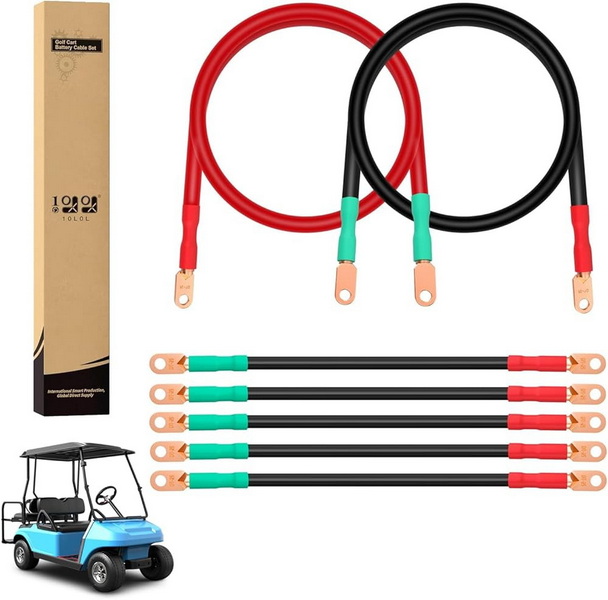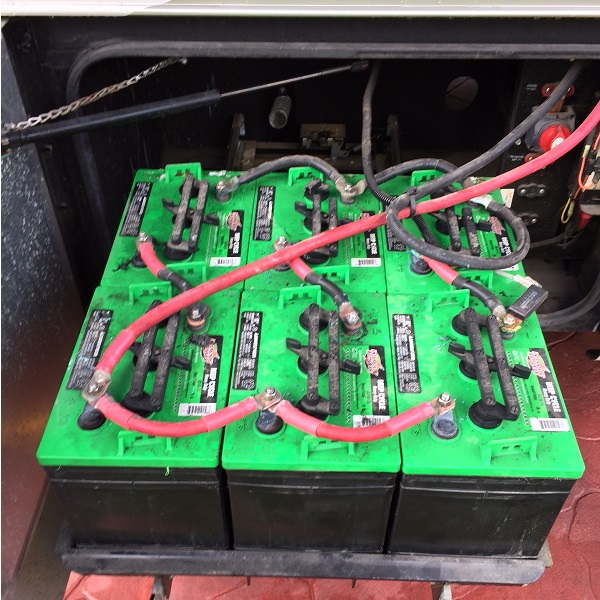Content Menu
● Understanding Golf Cart Battery Systems
>> Battery Configuration
● Battery Cables in Electric Golf Carts
>> Typical Number of Battery Cables
>> Interconnect Cables
● Importance of Battery Cables
>> Cable Gauge
● Maintaining Golf Cart Battery Cables
● Upgrading Battery Cables
● Impact of Battery Configuration on Cable Count
>> 36-Volt vs. 48-Volt Systems
● Cable Routing and Organization
● The Role of Battery Management Systems
● Environmental Considerations
● Future Trends in Golf Cart Battery Systems
● Conclusion
● Frequently Asked Questions (FAQ)
>> 1. How often should I inspect my golf cart's battery cables?
>> 2. Can I upgrade my golf cart's battery cables for better performance?
>> 3. What are the signs that my golf cart's battery cables need replacement?
>> 4. How do lithium-ion batteries affect the cable configuration in golf carts?
>> 5. Are there any safety precautions I should take when working with golf cart battery cables?
Electric golf carts are becoming increasingly popular for their quiet operation, low maintenance, and eco-friendly nature. One of the most crucial components of these vehicles is their battery system, which includes the battery cables. In this comprehensive guide, we'll explore the number of battery cables in an electric golf cart, their importance, and related aspects of golf cart battery systems.

Understanding Golf Cart Battery Systems
Before delving into the number of battery cables, it's essential to understand the basic structure of a golf cart battery system.
Battery Configuration
Most electric golf carts use a series of 6-volt or 8-volt batteries to achieve the required voltage for operation. The most common configurations are:
- 36-volt system: Six 6-volt batteries
- 48-volt system: Six 8-volt batteries or eight 6-volt batteries
Battery Cables in Electric Golf Carts
The number of battery cables in an electric golf cart depends on several factors, including the voltage system and the specific model of the cart. However, we can provide a general overview.
Typical Number of Battery Cables
In a standard 36-volt or 48-volt golf cart, you can expect to find the following battery cables:
1. Main positive cable (from battery pack to controller)
2. Main negative cable (from battery pack to controller)
3. Motor positive cable (from controller to motor)
4. Motor negative cable (from controller to motor)
5. Interconnect cables between batteries (number varies based on configuration)
Interconnect Cables
The number of interconnect cables depends on the battery configuration:
- For a 36-volt system with six 6-volt batteries: 5 interconnect cables
- For a 48-volt system with six 8-volt batteries: 5 interconnect cables
- For a 48-volt system with eight 6-volt batteries: 7 interconnect cables
Importance of Battery Cables
Battery cables play a crucial role in the performance and safety of electric golf carts:
1. Power transmission: They carry the electrical current from the batteries to the motor and other components.
2. Efficiency: Proper gauge and quality cables ensure minimal power loss.
3. Safety: Well-maintained cables prevent short circuits and electrical fires.
Cable Gauge
The gauge of the battery cables is crucial for optimal performance. Most golf carts use 4 AWG (American Wire Gauge) or 2 AWG cables for the main power cables. Thicker cables (lower AWG number) can handle more current and are often used in high-performance carts.
Maintaining Golf Cart Battery Cables
Proper maintenance of battery cables is essential for the longevity and performance of your golf cart. Here are some key maintenance tips:
1. Regular inspection: Check for signs of wear, corrosion, or damage.
2. Cleaning: Keep terminals and connections clean and free of corrosion.
3. Tightening: Ensure all connections are tight to prevent power loss and overheating.
4. Replacement: Replace cables showing signs of significant wear or damage.
Upgrading Battery Cables
Some golf cart owners choose to upgrade their battery cables for improved performance. Reasons for upgrading include:
1. Increased power output
2. Reduced voltage drop
3. Better heat dissipation
4. Enhanced overall efficiency
When upgrading, it's crucial to choose the right gauge and quality of cables to match your golf cart's specifications and intended use.
Impact of Battery Configuration on Cable Count
The battery configuration of your golf cart not only affects the number of interconnect cables but also influences the overall performance and range of the vehicle.
36-Volt vs. 48-Volt Systems
- 36-volt systems are common in older or more basic golf carts. They typically use six 6-volt batteries.
- 48-volt systems are becoming more popular due to their increased power and efficiency. They can use either six 8-volt batteries or eight 6-volt batteries.
The choice between these systems impacts the number of cables and the overall wiring complexity of the golf cart.
Cable Routing and Organization
Proper routing and organization of battery cables are crucial for several reasons:
1. Safety: Prevents cables from coming into contact with moving parts or hot surfaces.
2. Efficiency: Minimizes cable length to reduce resistance and power loss.
3. Maintenance: Makes it easier to inspect and replace cables when necessary.
4. Aesthetics: Keeps the battery compartment tidy and professional-looking.
When installing or replacing cables, it's important to follow the manufacturer's guidelines for routing and securing the cables.
The Role of Battery Management Systems
Modern golf carts often incorporate Battery Management Systems (BMS), which can impact the wiring and cable configuration. A BMS typically requires additional wiring to monitor individual battery voltages and temperatures.
Benefits of a BMS include:
1. Extended battery life
2. Improved charging efficiency
3. Real-time monitoring of battery health
4. Enhanced safety features
While a BMS may increase the overall cable count in a golf cart, the benefits often outweigh the added complexity.
Environmental Considerations
The type and quality of battery cables can have environmental implications:
1. Durability: High-quality cables last longer, reducing waste.
2. Materials: Some cables use more eco-friendly materials or manufacturing processes.
3. Efficiency: Better cables can improve the overall efficiency of the golf cart, potentially reducing energy consumption.
When selecting or replacing battery cables, consider both performance and environmental factors.
Future Trends in Golf Cart Battery Systems
As technology advances, we're seeing new trends in golf cart battery systems that may impact cable configurations:
1. Lithium-ion batteries: These often require different wiring setups compared to traditional lead-acid batteries.
2. Solar charging systems: Integration of solar panels may introduce additional wiring.
3. Regenerative braking: This technology can add complexity to the motor wiring.
4. Smart charging systems: These may require additional data cables for communication.
Staying informed about these trends can help you make better decisions when maintaining or upgrading your golf cart.
Conclusion
Understanding the battery cable system in your electric golf cart is crucial for proper maintenance and performance optimization. While the exact number of cables can vary depending on the voltage system and specific model, a typical electric golf cart will have between 9 and 13 battery cables, including the main power cables and interconnect cables.
Regular inspection and maintenance of these cables are essential for the longevity and efficiency of your golf cart. Whether you're a golf course manager, a golf cart enthusiast, or a casual user, being knowledgeable about your cart's battery system can help you keep it running smoothly for years to come.
As technology continues to evolve, we may see changes in battery systems and cable configurations. Staying informed about these developments can help you make the best decisions for your golf cart's maintenance and upgrades.

Frequently Asked Questions (FAQ)
1. How often should I inspect my golf cart's battery cables?
It's recommended to inspect your golf cart's battery cables at least once a month. Look for signs of wear, corrosion, or loose connections. If you use your cart frequently or in harsh conditions, more frequent inspections may be necessary.
2. Can I upgrade my golf cart's battery cables for better performance?
Yes, upgrading to higher quality or larger gauge battery cables can improve your golf cart's performance. However, it's important to ensure that any upgrades are compatible with your cart's electrical system and follow proper installation procedures.
3. What are the signs that my golf cart's battery cables need replacement?
Signs that your battery cables may need replacement include visible wear or fraying, corrosion that can't be cleaned, loose connections that won't stay tight, or a noticeable decrease in your cart's performance or range.
4. How do lithium-ion batteries affect the cable configuration in golf carts?
Lithium-ion batteries often require different wiring setups compared to traditional lead-acid batteries. They may need specialized Battery Management Systems (BMS) and different cable gauges. Always consult with a professional or the manufacturer when switching to lithium-ion batteries.
5. Are there any safety precautions I should take when working with golf cart battery cables?
Absolutely. Always disconnect the main power source before working on battery cables. Wear protective gear such as gloves and safety glasses. Be cautious of short circuits and ensure you're working in a well-ventilated area. If you're unsure, it's best to consult with a professional.









































